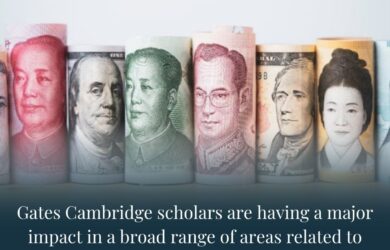A new kind of energy transfer from organic to inorganic semiconductors has been discovered which paves the way for boosting the efficiency of widely used inorganic solar cells with the help of a cheap organic coating.
A new kind of energy transfer from organic to inorganic semiconductors has been discovered which paves the way for boosting the efficiency of widely used inorganic solar cells with the help of a cheap organic coating.
The research team who made the discovery have published their findings in Nature Materials in an article on which Gates Cambridge Scholar Maxim Tabachnyk is lead author.
Maxim [2012], who is doing a PhD in Physics, says: “To develop clean, sustainable and cheap energy sources that can gradually reduce and finally replace the consumption of fossil fuels is one of the major challenges that modern science is facing. Innovative energy sources are needed to reduce the negative environmental impact that burning hydrocarbons, currently the main energy source, has been causing. Further, within this century we will run out of fossil fuels and need a vision how to provide enough energy for future generations with more and more people around the world rising up to an energy-intensive lifestyle.”
Solar cells represent such a clean energy source which produces electricity from sunlight. In the last 50 years semiconductor and solar cell research has focused on silicon as the active material. The fabrication of silicon solar cells has been optimised and their spread skyrocketed in the last decade. However, the maximum power conversion efficiency of silicon-based solar cells is fundamentally limited.
The energy of light is carried by particles called photons. The sun emits photons of various energies, blue photons are, for example, more energetic than red photons. Silicon has a maximum energy that it can extract from each photon and convert to electrical energy. All remaining energy is lost to heat.
The research team led by Dr Akshay Rao found that it could be possible to boost efficiency of the inorganic silicon solar cell by combining it with a cheap organic coating. The crucial property of the organic – a small molecule called pentacene – is its ability to split high energy excitations into two packages.
Maxim says: “We found that it is possible to transfer both of these packages onto an inorganic semiconductor. That means that instead of generating only one energy unit per high-energy light particle as in traditional solar cells, we can generate two energy units in silicon by combining it with the organic. Another advantage of organics is their processability in solution. That means we can have the organic in an ‘ink’ and cheaply print or possibly even spray the organic on top of a traditional silicon solar cell. This process could be easily and cheaply integrated in existing solar cell fabrication lines or even done in a post-fabrication step. Due to the flexibility in processing and operation, our technology could also improve the performance of other evolving technologies such as perovskite or other thin film solar cells.”
The discovered process of the novel energy transfer paves the way not only to new applications improving solar cells, but potentially also light emitting diodes, sensors or lasers. The team is now investigating how the discovered energy transfer can be extended to other organic/inorganic systems and is developing a cheap organic coating that could be used to boost the power conversion efficiency of conventional solar cells, making them more competitive with alternative energy sources.












